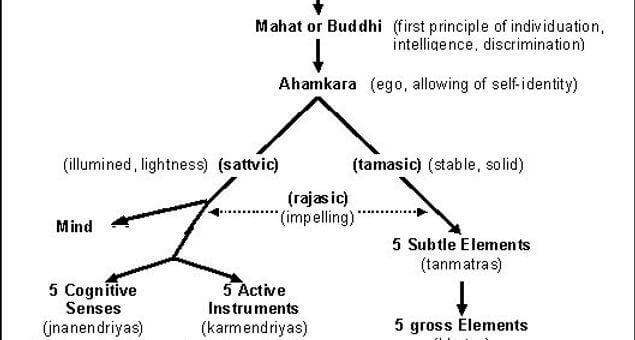Author: Randeep Singh / go to all Samkhya Karikas

Samkhya karika 22 text:
Prakrteh mahat tatah ahamkarah tasmat ganah ca shodasakah |
Tasmad api shodasakat pancabhyah panca bhutani ||
Prakrteh – from Prakriti
Mahan / Mahat – the great one
Tatah – therefrom, from that
Ahamkarah – Ego, the identification principle
Tasmat – from that
Ganah – collection, a set
Ca – and
Shodasakah – sixteen
Tasmad api – thus also
Shodasakat – from those sixteen
Pancabhyah – from the five
Panca – the five
Bhutani – elements emerge
Samkhya Karika 22 explains the beginning of the process of evolution of the material universe after Purusha and Prakriti come together. Though the universe may appear too complex and entangled to an untrained eye, in fact the construct of the universe becomes easy to comprehend if one can know about the basic building blocks out of which it is build up. This is the first karika, from a series of them to subsequently unveil, which is talking about the emergence of the first, major, fundamental blocks of evolution (the 23 evolutes apart from the two parent entities: Purusha & Prakriti) which join each other in various permutations and combinations to create the entire universe.
First Mahat and Ahamkara emerge
As Prakriti and Purusha come near to each other the composition of Prakriti begins to change in preparation for the evolutions of the first 23 principles of which the entire material world is made up of. Mahat / Mahan is the first emergent principle of Prakriti as it begins to transform due to proximity to Purusha. It is also known as Buddhi or the intellect.
Buddhi is the subtlest of all the other 22 principles as it exists nearest to the Prakriti (in its unmanifest form which is subtle) and Purusha which is the subtlest in construct. Since the subtleness of Buddhi is very close to that of Purusha, though it is a part of Prakriti, it appears as though it is Purusha, the consciousness itself. It appears to have taken the nature of Purusha due to its proximity, in location as well as construct, to Purusha.
For Instance, heat is not the nature of water but it becomes hot, takes over the nature of heat, when it comes near to the source of heat, the fire. Similarly, the light and heat of the Sun as exhibited / reflected by the Earth is not its own nature but it appears to be its nature due to its proximity to the Sun. Thus, buddhi appears to have taken the nature of Purusha due to its proximity to it. This is the reason that buddhi, intellect is the biggest hurdle for the one who is working on the path to realize Purusha, as it fools the seeker by projecting itself as Purusha to him.
From Buddhi evolves Ahamkara, the identification principle which imparts the sense of individuation to the entity to e expressed. It is an empirical ego which makes the individual operate as separate from the whole, or countless others. The individual identifies itself with the limited self as a separate entity and not as one of the whole. It also means being conscious of the self, as a separate conscious, than the universal conscious.
Sixteen principles to five elements | Samkhya Karika 22
From Ahamkara evolve the set of sixteen entities / evolutes which will be described in detail in the following Samkhya Karikas. Five subtle elements or potentialities of five gross elements are a part of these sixteen. These subtle elements with potentialities are known as five Tanmatras from each of which evolve the five gross elements knwn as the Mahabhutas. Five karmendriyas (organs of action) and five Jnanendriyas (organs or perception) along with Manas also evolve from these sixteen which will be explained in the karikas to come further.
This Samkhya Karika only talks about the five elements (panca mahabhutas) which emerge from the Tanmatras (subtle atomic substance). The Five elements are listed here.
- Akasha – space
- Vayu – air
- Teja – fire/heat
- Jala/Apa – water
- Prithvi – earth
Samkhya describes how we came into being; how this universe (the phenomenal world) was created.
Since, we have not heard of this from childhood, it looks strange. We are unable to understand it completely. However, if we put in an effort to understand it, it will help us to rise above our miseries.
It is just like cooking; very tedious in the beginning, when we don’t know how to cook food. But when we learn and cook daily, read and discuss about it, then it becomes quite easy and simple.
In the Mahabharata, when Arjuna comments that to rein in the mind is as difficult as to rein the wind, Krishna replies thus “No doubt it is difficult but it is not impossible-with abhyas and vairagya (practice and restraint) this can be controlled.” Saint Kabir has also said that with practice even a fool can become wise, just like a rope, causing continuous friction, can wear off a hard rock.
The underlying meaning is that Samkhya is, no doubt, difficult, but by repeated reading, discussions and contemplation it can be understood.
A few understood it and applied it in their lives but most of us leave it thinking it is too difficult and incomprehensible.
Doubt (samsaya) is the chief reason of our misery. Life and death are an arrangement of nature. We do not try to understand this arrangement and think in terms of just birth and death. Rising above such thoughts will only liberate us. While intelligence is just a part of us, the whole problem is we think of intelligence as the only thing. We need to just observe the consciousness and not the intelligence.
